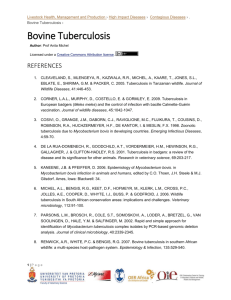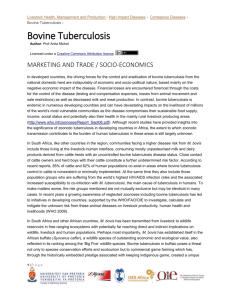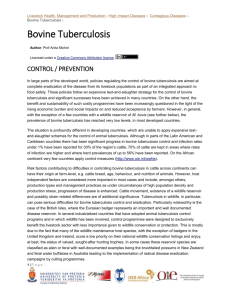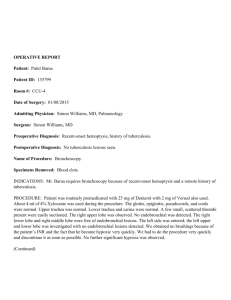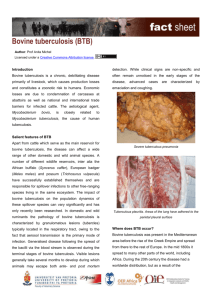bovine_tuberculosis_4_diagnosis
advertisement
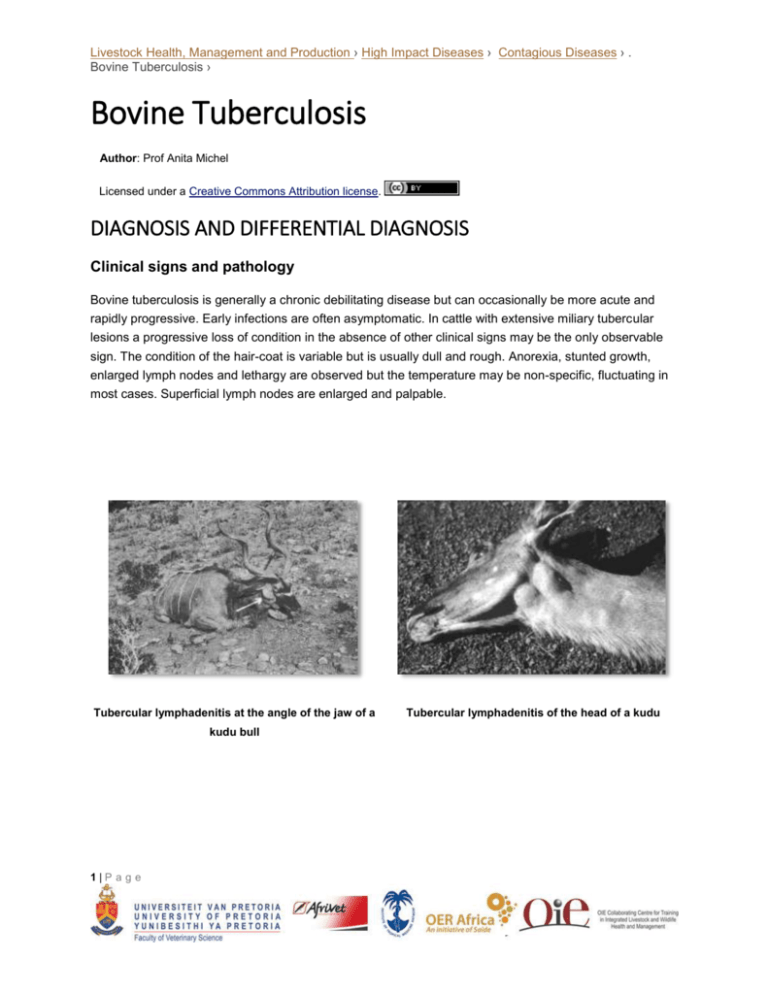
Livestock Health, Management and Production › High Impact Diseases › Contagious Diseases › . Bovine Tuberculosis › Bovine Tuberculosis Author: Prof Anita Michel Licensed under a Creative Commons Attribution license. DIAGNOSIS AND DIFFERENTIAL DIAGNOSIS Clinical signs and pathology Bovine tuberculosis is generally a chronic debilitating disease but can occasionally be more acute and rapidly progressive. Early infections are often asymptomatic. In cattle with extensive miliary tubercular lesions a progressive loss of condition in the absence of other clinical signs may be the only observable sign. The condition of the hair-coat is variable but is usually dull and rough. Anorexia, stunted growth, enlarged lymph nodes and lethargy are observed but the temperature may be non-specific, fluctuating in most cases. Superficial lymph nodes are enlarged and palpable. Tubercular lymphadenitis at the angle of the jaw of a kudu bull 1|P a g e Tubercular lymphadenitis of the head of a kudu Livestock Health, Management and Production › High Impact Diseases › Contagious Diseases › . Bovine Tuberculosis › Tubercular lymphadenitis of a parotid lymph node A cow with subcutaneous lesions caused by MOTT In the majority of cases (90-95%) the route of transmission is by inhalation resulting in the respiratory tract being affected and often in pulmonary tuberculosis. A chronic cough due to bronchopneumonia indicates pulmonary involvement, but is never loud but moist and worst in the morning. Dyspnoea is more common in advanced or terminal stages. A low grade fever is usually observed, as well as weakness and in appetence. When the GIT is involved, intermittent diarrhoea and constipation may be observed. Reproductive disorders include uterine tuberculosis in advanced cases and may result in infertility or recurrent abortion following conception. Clinical signs may further include mucopurulent discharges, vulvar discharges and a placentitis similar to Brucella abortus infection. Irregular oestrous and abscesses in testes may be observed. Lesions of bovine tuberculosis may also be found in the vertebrae, ribs and flat bones of the pelvis, especially in young animals. In advanced cases, lesions in the central nervous system may lead to loss of vision, incoordination in gait, partial paralysis, and circling. Under stressful conditions, such as in malnutrition and post-calving, the clinical signs of BTB are generally more pronounced. In cattle, lesions usually appear in the pharynx, thoracic cavity and the lungs. In the affected respiratory tract the granulomatous lesions, so-called tubercles, are found in the retropharyngeal, mediastinal and bronchial lymph nodes. Lesions are also found in the lungs to complete the primary complex. Lung lesions may appear microscopically or macroscopically as encapsulated yellowish foci of caseous necrosis. The lung lesions may spread to the visceral and parietal pleura, where they occur in masses and sometimes fuse together. 2|P a g e Livestock Health, Management and Production › High Impact Diseases › Contagious Diseases › . Bovine Tuberculosis › Severe tuberculous pneumonia A section through tubercular lesions in the mesenteric lymph nodes Tuberculous pleuritis. Areas of the lung have Tubercular lesions in the ovary and fallopian tube of adhered to the parietal pleural surface a cow 3|P a g e Livestock Health, Management and Production › High Impact Diseases › Contagious Diseases › . Bovine Tuberculosis › Video link: http://youtu.be/XqGWBO0_8Bs Gastro-intestinal tract (GIT) lesions are the second most common form of bovine tuberculosis. The lesions appear as nodules and/or ulcers in the mucosa of the upper alimentary tract, abomasum, small intestine and large intestine. Ulcers develop first in Peyer's patches in the small intestines. Generalized or miliary tuberculosis manifests as small but numerous lesions in a number of organs of the body, following dissemination of the bacilli by haematogenous spread and subsequent localization in various organs of the body, followed by development of tubercles in the affected organs. Various forms of tuberculosis can be manifested in the udder of bovines. This ranges from a scenario where most of the glandular lobules are replaced by granulomatous tissue to a case where there are clusters of small lobules that have calcified. The resultant mastitis is therefore variable, ranging from caseous tuberculous mastitis to tuberculous galactophoritis. 4|P a g e Livestock Health, Management and Production › High Impact Diseases › Contagious Diseases › . Bovine Tuberculosis › Video link: http://youtu.be/TRisOhVe7XM Laboratory confirmation Indirect detection methods comprise those techniques which exploit the immune response mounted by infected animals. A distinction is made between the early, cell mediated immune response and the antibody based, or humoral, immune response which is elicited during the advanced stages of bovine tuberculosis. The first and best-known immunological test for tuberculosis diagnosis is the tuberculin skin test. The same principle is used for testing in both, animals and humans and although imperfect, the tuberculin test has not yet been replaced by any other more accurate or satisfactory method. Some of the main deficiencies of the test are its inability to differentiate between distinct species of the M. tuberculosis complex, failure to distinguish between latent stages of infection and disease and failure to distinguish vaccinated and infected individuals. In addition, anergy (the disease stage when the immune response has switched from cellular to humoral immunity and consequently infected animals are no longer reactive to the skin test or interferon gamma assay), exposure to environmental mycobacteria and operator errors can lead to false results. Two recent studies also suggested that the cut-off generally used for positive test interpretation (>4mm) may not be applicable for at least some countries in sub-Saharan Africa and that a cut-off >2mm could be more appropriate in some settings. The more recently developed Bovigam® test for cattle detects the production of interferon gamma in (in vitro) stimulated blood samples. Applied in both standard commercial and customised test formats this assay has contributed significantly to the improved detection of early M. bovis infection in cattle as well as an increasing number of wildlife species (e.g. non-human primates, cervids). Recent improvements of the test include the use of two M. tuberculosis complex specific antigens, ESAT-6 and CFP-10, which has resulted in increased test specificity. The tuberculin skin test and the interferon gamma test are both based on the detection of the 5|P a g e Livestock Health, Management and Production › High Impact Diseases › Contagious Diseases › . Bovine Tuberculosis › early cell-mediated immune response in tuberculosis infection. However, at late disease stages, the cellmediated immune response can wane as opposed to a generally increasing humoral immune response and the tuberculin skin test or Bovigam® tests can therefore give false negative results in these so-called anergic animals. This is of importance for the diagnosis of bovine tuberculosis in settings where no or little disease control measures are applied and where the percentage of late stage diseased animals is believed to be high. Therefore, in developing countries, serological tests, which are based on the detection of the humoral immune response, may be of particular use. Unfortunately, to date, no satisfactory serological test is available. Some of the problems related to the development of serological tests for tuberculosis diagnosis include the observed highly variable antibody responses between individuals to mycobacterial antigens and antigenic variation between mycobacterial strains. However, a recently developed lateral flow test that is based on the detection of more than one antigen has shown promising results for tuberculosis diagnosis in certain animal species (e.g. in elephant), although it may not be suitable for others, such as buffaloes. Another recently developed serological test for animals is based on antibody detection using fluorescence polarisation but has shown variable effectiveness in different settings. Direct methods for tuberculosis diagnosis are based on the isolation or detection of the bacterium in sputum samples or biopsies (mostly in humans) or at post-mortem examination, from tuberculous organ lesions (generally in animals). The presence of Mycobacteria in a given sample can be assessed by Ziehl-Neelsen staining followed by light microscopy or auramine O staining and fluorescence microscopy. Recent work with M. tuberculosis suggests that the auramine O staining technique may be more sensitive and specific than Ziehl-Neelsen staining. However, microscopic detection of Mycobacteria shows a generally low sensitivity (from 50-70%) for human sputum samples. A much higher sensitivity can be achieved by prior culture of the bacteria. Culture is still regarded as the gold standard for tuberculosis diagnosis despite certain deficiencies. For example, the yield of culturable (quantities) of bacteria from blood, urine, lavage and cerebrospinal fluid is very low. Bacterial culture is also time consuming and does by itself not allow the differentiation between distinct mycobacterial species However, in many cases, culture is a prerequisite for further testing and characterization of Mycobacteria. Ziehl-Neelsen stained film with large numbers of acid-fast mycobacterial organisms appearing as small pink-staining rods 6|P a g e Livestock Health, Management and Production › High Impact Diseases › Contagious Diseases › . Bovine Tuberculosis › Video link: http://youtu.be/NnZsh7i6iB4 Tuberculin skin test PCR (polymerase chain reaction)-based techniques are indispensable for the direct detection and accurate differentiation of mycobacterial species and molecular epidemiological investigations of tuberculosis transmission (for detailed technical information on this subject the reader is referred to the more specific literature). Although biochemical techniques also allow the differentiation between distinct mycobacterial species, these methods are very laborious, time consuming and appear to be erroneous. PCR can be used for any sample material in theory, but has some problems of its own e.g., certain samples may contain PCR inhibitors, which could lead to false negative results. Conversely, the generation of a vast number of DNA amplicons can quickly give rise to false positive results. Moreover, the technique requires a relatively sophisticated laboratory and well trained technicians. Differential diagnosis Conditions in cattle that may cause clinical signs similar to bovine tuberculosis are: Traumatic reticulitis. Chronic pasteurellosis. Foreign body or aspiration pneumonia. Pharyngeal obstruction. 7|P a g e Livestock Health, Management and Production › High Impact Diseases › Contagious Diseases › . Bovine Tuberculosis › Actinobacillosis. Arcanobacterium pyogenes infection. Corynebacterium pseudotuberculosis infection. Mastitis caused by other organisms. At necropsy or inspection of carcasses at abattoirs, the granulomatous lesions of tuberculosis may be confused with: those caused by infectious agents such as fungi, staphylococci, Arcanobacterium and Actinobacillus spp., foreign body pneumonia, and "pearl disease" with pleural or peritoneal mesothelioma. 8|P a g e
